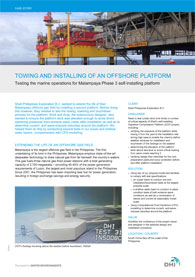Testing the marine operations for Malampaya Phase 3 self-installing platform
We assessed the towing, lowering and touchdown process for the platform by conducting several tests in our ocean and shallow water basins, complemented with CFD modelling.

Malampaya is the largest offshore gas field in the Philippines. In order to maintain production from and extend the life of Malampaya, Shell Philippines Exploration B.V. decided to install a second platform – Depletion Compression Platform (DCP) – to facilitate compression into the gas field. They selected a self-installing platform (designed by Arup and built at Keppel Shipyard in Subic Bay) that was later towed to the field site.
In order to prevent large volumes of water from entering the platform during the wet tow operation, the platform needed sufficient freeboard to minimise green water on deck. Our wet tow test verified the elevation of the outer wall on the platform and determined if the design needed to be modified. The installation tests focused on the forces between the barge and the platform legs at different stages of submergence until final touchdown.
In addition, we tested the design requirement in our shallow water wave basin to determine the minimum air gap between the wave crests and the platform deck after installation. The setup included the DCP and the neighbouring existing platform. We were able to determine flow velocities generated by a combination of waves and ambient currents, which could be used as a basis for the design of:
- the seabed rock preparation pads (which support the footings of the platform legs)
- permanent scour protection around the platform footings
We further analysed flow velocities at the seabed and the effect of irregular waves on the near-bed flow field around the platform legs using CFD modelling with OpenFOAM®. Our analysis of the flow field yielded a mapping of local zones that are sensitive to scour development. Coupled with the local velocity amplification, this formed the basis for scour risk assessment, allowing for countermeasures to be taken for relevant parts of the platform footings.
Read more